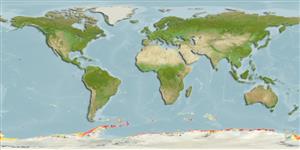Common names from other countries
Classification / Names / Names
Common names | Synonyms | Catalog of Fishes (gen., sp.) | ITIS | CoL | WoRMS
Environment: milieu / climate zone / depth range / distribution range
Ecology
Pelagic-oceanic; depth range 400 - 2000 m (Ref. 1812). Temperate; 5°C - 8°C (Ref. 1812); 32°S - 76°S, 0°E - 0°E
Antarctic and sub-Antarctic waters. Common in Southeast Pacific.
Length at first maturity / Size / Weight / Age
Maturity: Lm ? range ? - ? cm Max length : 10.5 cm BL male/unsexed; (Ref. 3682)
Antarctic specimens are much larger (up to 10.5 cm) than sub-Arctic specimens (up to 7 cm). Maximum depth reported taken from Ref. 116364.
Life cycle and mating behavior
Maturity | Reproduction | Spawning | Eggs | Fecundity | Larvae
Members of the phylum Chaetognatha are hermaphroditic. Mating behavior: A preliminary visual signaling behavior for species recognition is observed to prevent predation. Life cycle: Eggs directly develop into miniature adults (hatchlings).
Pierrot-Bultz, A. 2004. (Ref. 3682)
IUCN Red List Status (Ref. 130435: Version 2024-1)
CITES status (Ref. 108899)
Not Evaluated
Not Evaluated
Human uses
| FishSource |
Tools
More information
Age/Size
Growth
Length-weight
Length-length
Morphology
Larvae
Abundance
Internet sources
Estimates based on models
Preferred temperature
(Ref.
115969): -0.6 - 1, mean 0.4 (based on 226 cells).
Vulnerability
Low vulnerability (10 of 100).
Price category
Unknown.
